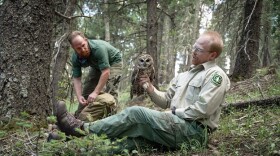On a walk through the woods, you might see a strange-looking growth up in the branches of a tree. It’s called a witches' broom — a dense, tangled cluster of twigs and shoots that looks like a broom, hence the common name.
Witches’ broom is found in many kinds of woody trees and shrubs, such as Douglas-fir and ponderosa pine.
In those trees, dwarf mistletoe is the cause. The mistletoe is a true parasite, getting almost all its water and nutrients from the host plant. The presence of mistletoe can then induce the growth of a broom.
For a long time, both mistletoe and the resulting witches’ broom have been viewed as something to eliminate. They can spread from tree to tree, and if a tree is stressed, it may die.
But on the positive side, researchers have found witches’ brooms are a big boon to wildlife. They provide structure in the forest — cover, shade, nest sites and even food for lots of creatures. Birds nest, roost and forage for insects in them. For Mexican spotted owls, it’s their first choice of habitat.
Among mammals, squirrels, porcupines, and skunks use them as warm protective nests and places to stash cones and seeds. One biologist even saw signs of a mountain lion in a very large broom near the ground in a Douglas-fir!
So witches’ brooms aren’t so spooky after all. Appreciating their benefits could help land managers decide whether to keep or remove certain trees for a healthier forest and for the wildlife within.
This Earth Note was written by Rose Houk and produced by KNAU and the Sustainable Communities Program at Northern Arizona University.







